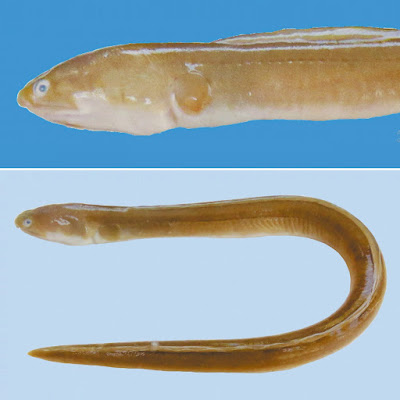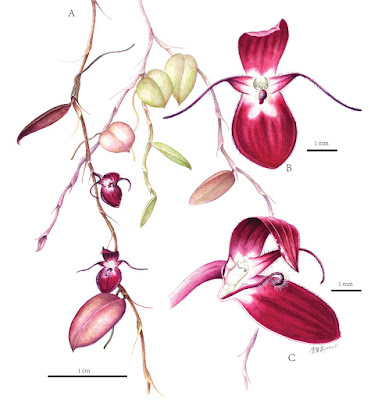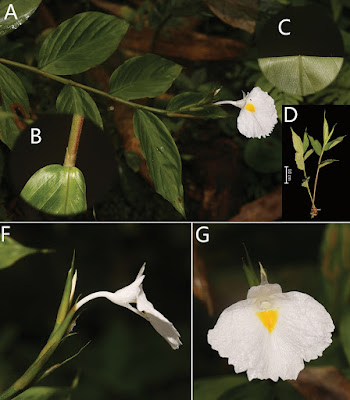[Most Recent Entries] [Calendar View]
Sunday, January 12th, 2020
| Time | Event | ||||||||
| 1:03p | [Ichthyology • 2019] Ophichthus vietnamensis • A New Species of the Snake Eel Genus Ophichthus (Anguilliformes: Ophichthidae), with Additional Records from Viet Nam
A new species of snake eel, Ophichthus vietnamensis sp. nov., is described on the basis of two specimens collected from off Ky Ha, central coast of Viet Nam. The new species is distinguishable from four similar congeners by having two preopercular pores, a less elongate body (both depth 20–25 times in TL) and the following combination of characters: tail length 56% TL; teeth moderately large and conical, biserial along the entire upper jaw, biserial anteriorly and uniserial posteriorly on lower jaw, uniserial on vomer, and total vertebrae 121–130. Five Ophichthus species are also found in Vietnamese waters, including O. asakusae, O. erabo, O. lithinus, O. rutidoderma and O. urolophus. Detailed descriptions are provided for all species. Key words: Pisces, Taxonomy, Ichthyology, Snake eel, New species.
Ophichthus vietnamensis sp. nov. New English name: Vietnamese Snake Eel Diagnosis: A species of Ophichthus with posterior nostril above upper lip, covered by a flap that extends well below the edge of mouth and a less elongate body than other members of the genus (both depth 20–25 times in TL). It can be distinguished by the following combination of characters: tail length 56% TL; posterior end of tail thick, broadly pointed; dorsal origin above tip of appressed pectoral fin; pectoral fin broad and rounded; upper lips with a knob-like barbel at anterior margin of posterior nostril; cephalic sensory pores: SO 1 + 4, POM 8 – 9 + 2; teeth moderately large and conical, biserial along entire upper jaw, biserial anteriorly and uniserial posteriorly on lower jaw, uniserial on vomer; coloration yellowish-tan, slightly contrasting with white throat and belly; dorsal fin grayish with pale base, pectoral fin light brownish and anal fin uniformly pale; total vertebrae 121–130, mean vertebral formula 12-52- 125. Etymology: The specific name refers to the type locality (Vietnam) of the new species. CONCLUSIONS: Knowledge of the snake eel genus Ophichthus from Vietnamese waters has been expanded and reviewed. A new species is described, and five species are confirmed from specimens. Data are provided based on type series together with specimens newly collected from a broader range. Additional descriptive characters are employed for recognizing its congeners and to establish the new species. This study provides an additional understanding of snake eel species in Vietnamese waters. Additional collections are needed to help further understand the taxonomy of this group. Quang Van Vo, Yusuke Hibino and Hsuan-Ching Ho. 2019. A New Species of the Snake Eel Genus Ophichthus, with Additional Records from Viet Nam (Anguilliformes: Ophichthidae). Zoological Studies. 58:43. DOI: 10.6620/ZS.2019.58-.43. | ||||||||
| 1:37p | [Botany • 2020] Bulbophyllum papuaense • A New Species of Bulbophyllum sect. Oxysepala (Orchidaceae) from West Papua, Indonesia
Abstract A new species, Bulbophyllum papuaense, was described and illustrated from Indonesia. Bulbophyllum papuaense is similar to Bulbophyllum tortuosum and B. muscohaerens but differs from them by having rhizome and pseudobulbs covered with papillose scales, caudate and ciliate petals, linear and ciliate lip. Keywords: Bulbophyllum, Indonesia, new species, Orchidaceae
Bulbophyllum papuaense X.H.Jin, sp. nov. Diagnosis: Bulbophyllum papuaense is close to Bulbophyllum tortuosum and B. muscohaerens but differs from them by having rhizome and pseudobulbs covered with papillose scales, caudate and ciliate petals, linear and ciliate lip which curve at the tip.
Ecology: Bulbophyllum papuaense was discovered in broad-leaved, evergreen montane forest in Mokwan, West Papua. Bulbophyllum papuaense is epiphytic on trunks or shrub in humid and shady areas in montane forest. Plants are tiny and grow usually with moss. Our observation indicated that it was in full bloom in August. Bulbophyllum papuaense is only known from the type locality. Etymology: The name derives from the Papua, where the new species was discovered. Taxonomic notes: Bulbophyllum papuaense belongs to sect. Oxysepala which is often characterized by 1-flowered inflorescence, lateral sepals connate, basal node of pedicel near at same level with the attachment of floral bract (Vermeulen et al. 2015). Bulbophyllum papuaense is a distinctive species in sect. Oxysepala and easily differs from its relatives by its morphological characters, such as the rhizome with warty scales, caudate and ciliate petals, linear lip recurve and with white hairs. Dongliang Lin, Kailing Zhou, Arief Hidayat and Xiao-Hua Jin. 2020. Bulbophyllum papuaense (Orchidaceae), A New Species from Indonesia. In: Jin X-H, Xia N-H, Tan Y-H (Eds) Plant Diversity of Southeast Asia-II. PhytoKeys. 138; 125-130. DOI: 10.3897/phytokeys.138.38714 | ||||||||
| 3:58p | [Botany • 2020] Monolophus odontochilus (Zingiberaceae) • A New Species from Northern Myanmar with Two New Combinations of Monolophus from Indo-Burma
Abstract Monolophus odontochilus Y.H.Tan & H.B.Ding, a new species from Northern Myanmar, is described and illustrated. The new species is morphologically similar to M. linearis, but differs by having elliptic to oblong leaves (vs. linear-lanceolate to lanceolate), bilobed ligules (vs. entire), purely white corolla (vs. pinkish white), semi-orbicular crenate labellum (vs. trilobed). In addition, a diagnostic key to the new species of Monolophus and its closely related non-yellow flowered species is provided. New combinations are proposed here for Caulokaempferia phokhamii Picheans. & Douangde. and C. wongsuwaniae Picheans. & Douangde. from Laos. Keywords: Caulokaempferia phokhamii, Caulokaempferia wongsuwaniae, Kachin State, Putao District Monolophus odontochilus Y.H.Tan & H.B.Ding, sp. nov. Diagnosis: Monolophus odontochilus is morphologically similar to M. linearis (Wall.) Wall. from India in having white flowers with yellow blotch at the base of the labellum, but differs by having elliptic to oblong leaves (vs. linear-lanceolate to lanceolate leaves), bilobed ligules (vs. entire ligules), semi-orbicular crenate labellum (vs. trilobed labellum) and purely white corolla (vs. pinkish white corolla). Etymology: The species epithet ‘odontochilus’ refers to the crenate labellum. Distribution and habitat: Monolophus odontochilus is endemic to Kachin State, Northern Myanmar, only known from its type locality, Gathu Village, Putao District. It grows in humid environments or along streams of tropical rain forest at an elevation of 550–750 m. New combinations: Mood et al. (2014) have argued that the generic name Caulokaempferia is a superfluous name of genus Monolophus. A proposal to conserve Caulokaempferia by Intharapichai et al. (2014) has not yet been considered by the appropriate committee. Therefore, in our opinion, Monolophus is valid and the name Caulokaempferia must be rejected. Recently, Douangdeuane et al. (2019) described two new species under Caulokaempferia from Laos, which are transferred here to Monolophus. Monolophus phokhamii (Picheans. & Douangde.) Y.H.Tan & H.B.Ding, comb. nov. Basionym: Caulokaempferia phokhamii Picheans. & Douangde. in Douangdeuane et al., Pak. J. Bot. 51(1): 235. 2019. Type: Lao PDR. Vientiane Province, Hin Herb District, Phou Meut-Phou Kiykon Forest Conservation, Ban Hoiuy Dokmai (Hoiuy Dokmai Waterfall), ..., 270 m, 26 August 2014, CP260814-1 (holotype: BK, isotypes: MSU). Monolophus wongsuwaniae (Picheans. & Douangde.) Y.H.Tan & H.B.Ding, comb. nov. Basionym: Caulokaempferia wongsuwaniae Picheans. & Douangde. in Douangdeuane et al., Pak. J. Bot. 51(1): 237. 2019. Type: Lao PDR. Bolikhamxai Province, Mueang Tha Pabad District, Nam Tok Tad Mangkorn, ..., 200 m, 20 September 2014, CP200914-1 (holotype: BK, isotypes: MSU). Hong-Bo Ding, Bin Yang, Mya Bhone Maw, Pyae Pyae Win and Yun-Hong Tan. 2020. A New Species and Two New Combinations of Monolophus (Zingiberaceae) from Indo-Burma. In: Jin X-H, Xia N-H, Tan Y-H (Eds) Plant Diversity of Southeast Asia-II. PhytoKeys. 138; 155-162. DOI: 10.3897/phytokeys.138.39217 Bounleuane Douangdeuane, Boonmee Phokham, Pornpimon Wongsuwan and Chayan Picheansoonthon. 2019. The genus Caulokaempferia K. Larsen (Zingiberaceae) in Lao PDR part 1: Two new species from central Lao PDR. Pakistan Journal of Botany. 51(1); 235–240. DOI: 10.30848/PJB2019-1(23) |
| << Previous Day |
2020/01/12 [Calendar] |
Next Day >> |










